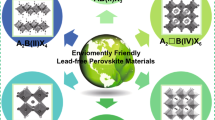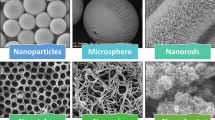Abstract
This work focuses on using rare-earth (RE) elements to titanium dioxide (TiO2) to fabricate effective photoanodes for dye-sensitized solar cells (DSSC) designed for indoor applications. Using a straightforward solid-state hand-grinding technique, different RE elements, including Nd+3, Sm+4, Er+3, and Yb+3 were used as dopants in TiO2. The impact of RE-doping on TiO2 bandgap engineering and device performance was thoroughly investigated. Enhanced photophysical properties of RE-doped TiO2 were unveiled through several characterization methods such as ultraviolet photoelectron spectroscopy (UPS), photoluminescence (PL) analysis, X-ray diffraction (XRD), and UV–visible absorption. These results led to the construction of DSSCs with RE-doped TiO2 that showed better photoconversion efficiency (PCE) than pristine TiO2 under household light sources such as white LED and CFL lamps with 1000 lux and 300 lux illuminance levels, respectively. Among them, Er+3-doped TiO2 exhibited the highest PCE. The PCE values were 6.7% under A.M1.5G light, 11.6% under LED light, and 7.9% under CFL light. External quantum efficiency (EQE) spectrum responses were in favor of enhanced PCE with RE-doped TiO2. Rapid electron injection from dye molecules to the conduction band (CB) of Er-doped TiO2 was observed by time-resolved photoluminescence (TRPL) analysis. Moreover, Er-doped TiO2-based DSSCs have reduced interfacial resistances, according to electrochemical impedance spectroscopy (EIS) tests. When the doped TiO2 photoanode was compared to other doped photoanodes, the optimal stoichiometry of Er (0.4%) showed greater PCE with enhanced current density (Jsc). The outcomes highlight the possibility of using rare-earth-doped TiO2 as a material to improve the efficiency of DSSCs that rely on indoor light.







Similar content being viewed by others
Data availability
Data will be available upon request.
References
A. Venkateswararao et al., Device characteristics and material developments of indoor photovoltaic devices. Mater. Sci. Eng. R. Rep. 139, 100517 (2020)
L. Liu, Q. Shi, C. Lee, A novel hybridized blue energy harvester aiming at all-weather IoT applications. Nano Energy 76, 105052 (2020)
M. Prauzek et al., Energy harvesting sources, storage devices and system topologies for environmental wireless sensor networks: a review. Sensors 18(8), 2446 (2018)
Y. Aoki, Photovoltaic performance of organic photovoltaics for indoor energy harvester. Org. Electron. 48, 194–197 (2017)
P.P. Ray, A survey on internet of things architectures. J. King Saud Univ.-Comput. Inform. Sci. 30(3), 291–319 (2018)
Y. Zhan, Y. Mei, L. Zheng, Materials capability and device performance in flexible electronics for the internet of things. J. Mater. Chem. C 2(7), 1220–1232 (2014)
P. Pérez-Higueras et al., Efficiency and acceptance angle of High concentrator photovoltaic modules: current status and indoor measurements. Renew. Sustain. Energy Rev. 94, 143–153 (2018)
C.L. Cutting, M. Bag, D. Venkataraman, Indoor light recycling: a new home for organic photovoltaics. J. Mater. Chem. C 4(43), 10367–10370 (2016)
C.Y. Chen et al., Perovskite photovoltaics for dim-light applications. Adv. Funct. Mater. 25(45), 7064–7070 (2015)
S. Biswas, H. Kim, Solar cells for indoor applications: progress and development. Polymers 12(6), 1338 (2020)
T. Matsui et al., Progress and limitations of thin-film silicon solar cells. Sol. Energy 170, 486–498 (2018)
B.-X. Chen et al., Achieving high-performance planar perovskite solar cell with Nb-doped TiO 2 compact layer by enhanced electron injection and efficient charge extraction. J. Mater. Chem. A 4(15), 5647–5653 (2016)
M. Grätzel, Dye-sensitized solar cells. J. Photochem. Photobiol., C 4(2), 145–153 (2003)
A.J. Nozik, Quantum dot solar cells. Physica E 14(1–2), 115–120 (2002)
T.M. Clarke, J.R. Durrant, Charge photogeneration in organic solar cells. Chem. Rev. 110(11), 6736–6767 (2010)
H.S. Jung, N.G. Park, Perovskite solar cells: from materials to devices. Small 11(1), 10–25 (2015)
N. Yan et al., Recent progress of thin-film photovoltaics for indoor application. Chin. Chem. Lett. 31(3), 643–653 (2020)
D. Devadiga et al., Dye-sensitized solar cell for indoor applications: a mini-review. J. Electron. Mater. 50(6), 3187–3206 (2021)
M. Freunek, M. Freunek, L.M. Reindl, Maximum efficiencies of indoor photovoltaic devices. IEEE J Photovolt. 3(1), 59–64 (2012)
H. Xiao et al., Investigation of self-powered IoT Sensor nodes for harvesting hybrid indoor ambient light and heat energy. Sensors 23(8), 3796 (2023)
V.S. Katta, V.R. Chappidi, S.S.K. Raavi, Plasmonic Au NPs embedded Ytterbium-doped TiO2 nanocomposites photoanodes for efficient indoor photovoltaic devices. Appl. Surf. Sci. 611, 155728 (2023)
D.F. Rodrigues et al., Passivation of the TiO2 surface and promotion of N719 dye anchoring with poly (4-vinylpyridine) for efficient and stable dye-sensitized solar cells. ACS Sustain. Chem. Eng. 9(17), 5981–5990 (2021)
V.S. Katta, V.R. Chappidi, S.S.K. Raavi, Lanthanide doped Titania photoanodes for enhanced performance of Indoor light energy harvesting DSSC devices. in Novel Optical Materials and Applications. 2021. Optica Publishing Group. (2021)
P. Gnida et al., Impact of TiO2 nanostructures on dye-sensitized solar cells performance. Materials 14(7), 1633 (2021)
M.C. Sil et al., Enhancement of power conversion efficiency of dye-sensitized solar cells for indoor applications by using a highly responsive organic dye and tailoring the thickness of photoactive layer. J. Power. Sources 479, 229095 (2020)
H. Mohammadian-Sarcheshmeh, R. Arazi, M. Mazloum-Ardakani, Application of bifunctional photoanode materials in DSSCs: a review. Renew. Sustain. Energy Rev. 134, 110249 (2020)
M. Mazloum-Ardakani, R. Arazi, Improving the effective photovoltaic performance in dye-sensitized solar cells using an azobenzenecarboxylic acid-based system. Heliyon 5(3), e01444 (2019)
M.S. Ahmad, A.K. Pandey, N. Abd Rahim, Advancements in the development of TiO2 photoanodes and its fabrication methods for dye sensitized solar cell (DSSC) applications. A review. Renew. Sustain. Energy Rev. 77, 89–108 (2017)
M.E. Yeoh, K.Y. Chan, Recent advances in photo-anode for dye-sensitized solar cells: a review. Int. J. Energy Res. 41(15), 2446–2467 (2017)
A. Mbonyiryivuze, et al., Titanium dioxide nanoparticles biosynthesis for dye sensitized solar cells application. (2015)
N.J. Vickers, Animal communication: when i’m calling you, will you answer too? Curr. Biol. 27(14), R713–R715 (2017)
R. Kushwaha et al., Synthesis and characterization of nitrogen-doped TiO2 samples and their application as thin film electrodes in dye-sensitized solar cells. J. Solid State Electrochem. 19(2), 507–517 (2015)
V.S. Katta et al., Defect engineered (Er 3+/Nd 3+) codoped TiO 2 photoanodes for enhanced photoelectrochemical and photovoltaic applications. Sustain. Energy Fuels 6(24), 5539–5556 (2022)
R.T. Ako et al., La modified TiO2 photoanode and its effect on DSSC performance: a comparative study of doping and surface treatment on deep and surface charge trapping. Mater. Chem. Phys. 172, 105–112 (2016)
V.S. Katta et al., Vacancies induced enhancement in neodymium doped titania photoanodes based sensitized solar cells and photo-electrochemical cells. Sol. Energy Mater. Sol. Cells 220, 110843 (2021)
V.S. Katta et al., Er3+ doped titania photoanode for enhanced performance of photo-electrochemical water splitting devices. Mater. Lett. 302, 130297 (2021)
V.S. Katta, V.R. Chappidi, S.S.K. Raavi, Samarium-doped TiO2 photoanodes for the molecular devices for solar energy conversion. in Photonics for Energy. SPIE (2021)
W. Li, Influence of electronic structures of doped TiO2 on their photocatalysis. Phys. Status Solidi RRL 9(1), 10–27 (2015)
A. Mehtab et al., Rare earth doped metal oxide nanoparticles for photocatalysis: a perspective. Nanotechnology 33(14), 142001 (2022)
L. Zhu et al., Doping in semiconductor oxides-based electron transport materials for perovskite solar cells application. Solar RRL 5(3), 2000605 (2021)
V.S. Katta et al., Enriched visible light absorption by Au-embedded Sm3+ doped TiO2 compact photoanode for enhanced dye-sensitized solar cell performance. Physica B 652, 414621 (2023)
V.S. Katta, C. Biswas, S.S.K. Raavi, Tunable broadband NIR PL emissions with (Nd3+/Er3+) codoped TiO2 via synergetic energy transfer. ACS Appl. Opt. Mater. 1(1), 147–158 (2022)
A.K. Kaliamurthy et al., Trap-assisted transition energy levels of SrF2: Pr3+− Yb3+ nanophosphor in TiO2 photoanode for luminescence tuning in dye-sensitized photovoltaic cells. Solar RRL 5(10), 2100411 (2021)
P. Dorenbos, Chemistry and structure of inorganic compounds a review on how lanthanide impurity levels change with a review on how lanthanide impurity levels changes with chemistry and structure of inorganic compounds. ECS J. Solid State Sci. Technol 2, R3001–R3011 (2013)
K. Prajapat et al., The evolution of organic materials for efficient dye-sensitized solar cells. J. Photochem. Photobiol. C: Photochem. Rev. 55, 100586 (2023)
J. Zhang et al., Synthesis and properties of (Yb, N)-TiO2 photocatalyst for degradation of methylene blue (MB) under visible light irradiation. Mater. Res. Bull. 70, 358–364 (2015)
Z. Zhang et al., Samarium ions doped titania photoelectrodes for efficiency influence of dye-sensitized solar cells. J. Electrochem. Soc. 163(5), A644 (2016)
L.P. D’Souza et al., Photoexcitation of neodymium doped TiO2 for improved performance in dye-sensitized solar cells. Mater. Des. 104, 346–354 (2016)
J.B. Pérez et al., Structural, optical, and photoluminescence properties of erbium doped TiO2 films. Vacuum 169, 108873 (2019)
F. Zhou et al., Fabrication and characterization of TiO2/Sepiolite nanocomposites doped with rare earth ions. Mater. Lett. 228, 100–103 (2018)
Y. Nagao et al., Experimental characterization of the electronic structure of anatase TiO 2: thermopower modulation. Appl. Phys. Lett. 97(17), 172112 (2010)
B. Choudhury, B. Borah, A. Choudhury, Ce–Nd codoping effect on the structural and optical properties of TiO2 nanoparticles. Mater. Sci. Eng. B 178(4), 239–247 (2013)
K. Boubaker, A physical explanation to the controversial Urbach tailing universality. Eur. Phys. J. Plus 126(1), 1–4 (2011)
C. Maheu et al., UPS and UV spectroscopies combined to position the energy levels of TiO 2 anatase and rutile nanopowders. Phys. Chem. Chem. Phys. 20(40), 25629–25637 (2018)
O. Prakash et al., Solution processable transition metal oxide ultra-thin films as alternative electron transport and hole blocking layers in dye sensitized solar cells. J. Photochem. Photobiol. A 418, 113385 (2021)
A. Listorti, B. O’regan, J.R. Durrant, Electron transfer dynamics in dye-sensitized solar cells. Chem. Mater. 23(15), 3381–3399 (2011)
J. Zhang et al., Effect of cerium doping in the TiO2 photoanode on the electron transport of dye-sensitized solar cells. J. Phys. Chem. C 116(36), 19182–19190 (2012)
M. Adachi et al., Determination of parameters of electron transport in dye-sensitized solar cells using electrochemical impedance spectroscopy. J. Phys. Chem. B 110(28), 13872–13880 (2006)
Funding
RSSK acknowledges the financial support of DST, India, for the following projects no's CRG/2019/003197. KVS acknowledges the financial support from CSIR-SRF (09/1001(0031)/2018-EMR-I), and VVR acknowledges the financial support from UGC-JRF.
Author information
Authors and Affiliations
Contributions
All authors contributed to the conception, design, and analysis. The Material preparation, data collection, and the preparation first draft of the manuscript were done by VR Chappidi and KV Seshiah, Suresh and SSK Raavi. VR Chappidi and KC Seshiah have contributed equally.All authors commented on previous versions of the manuscript and have read and approved the final manuscript. The project administration was done by SSK Raavi.
Corresponding author
Ethics declarations
Conflict of interest
The authors have no financial or non-financial interests to disclose.
Additional information
Publisher's Note
Springer Nature remains neutral with regard to jurisdictional claims in published maps and institutional affiliations.
Supplementary Information
Below is the link to the electronic supplementary material.
Rights and permissions
Springer Nature or its licensor (e.g. a society or other partner) holds exclusive rights to this article under a publishing agreement with the author(s) or other rightsholder(s); author self-archiving of the accepted manuscript version of this article is solely governed by the terms of such publishing agreement and applicable law.
About this article
Cite this article
Chappidi, V.R., Seshaiah, K.V., Madduri, S. et al. Rare-earth-doped TiO2 photoanode DSSCs for indoor photovoltaics: a comparative study. J Mater Sci: Mater Electron 35, 528 (2024). https://doi.org/10.1007/s10854-024-12261-9
Received:
Accepted:
Published:
DOI: https://doi.org/10.1007/s10854-024-12261-9




